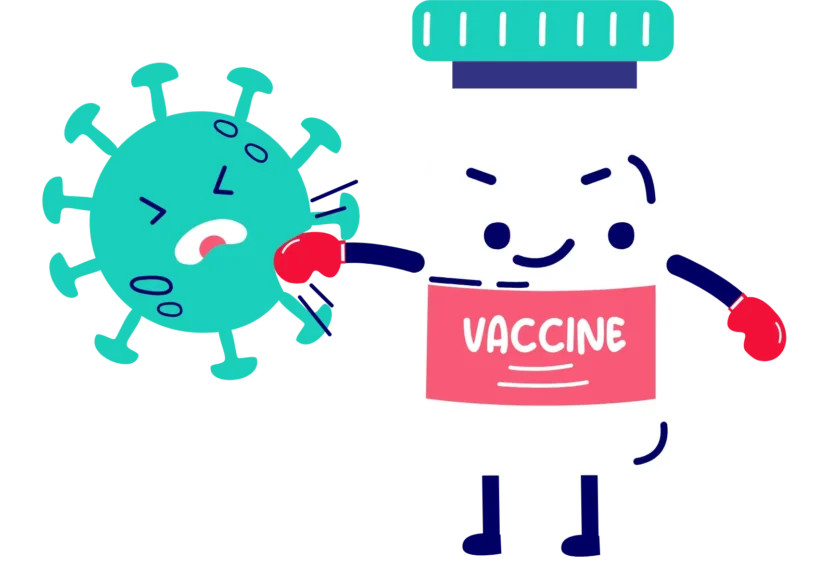Phone Number:
(+92)-309-8419000
Location:
Bahria Enclave Islamabad, Pakistan
Virus-Like Particles (VLP) Based Vaccines
Virus-like particle (VLP) vaccines use non-infectious particles that mimic viruses to stimulate an immune response without causing disease.
Virus-Like Particles (VLP) Based Vaccines
MRB Next GenTech specializes in the development of Virus-Like Particle (VLP) based vaccines, an advanced and highly effective approach within the realm of recombinant vaccines. VLPs closely mimic the structure of actual viruses but lack the viral genetic material, rendering them non-infectious. This makes VLPs an ideal platform for vaccine development, as they can elicit strong immune responses without the risk of causing disease. Our comprehensive services encompass the design, development, and production of VLP-based vaccines, tailored to target a wide range of infectious diseases and other medical conditions.
Benefits:
- Strong Immune Response: VLPs can induce both antibody and T-cell responses, providing comprehensive and long-lasting immunity.
- Safety: Since VLPs do not contain genetic material, there is no risk of infection or replication, making them extremely safe for use in vaccines.
- Rapid Development: The modular nature of VLPs allows for quick adaptation and production, which is crucial for responding to emerging infectious diseases.

Key Services:
Virus-Like Particle (VLP) Based Vaccines:
- Introduction: Virus-Like Particles (VLPs) are molecular structures that resemble viruses but are non-infectious as they lack the viral genome. VLP-based vaccines are created by assembling viral proteins into particles that mimic the natural virus, prompting the immune system to recognize and attack the target pathogen. These vaccines are highly effective at inducing both humoral (antibody-mediated) and cellular immune responses, providing robust protection against a variety of diseases.
- Technology: Our VLP-based vaccine development leverages advanced recombinant DNA technology. By expressing viral structural proteins in host cells (such as yeast, insect cells, or mammalian cells), we can produce self-assembling VLPs. These particles present viral antigens in their native conformation, ensuring an immune response that closely mimics natural infection. This technology is flexible, allowing for the rapid design and development of vaccines for emerging pathogens or personalized immunotherapy.
- Development Process: The process of developing VLP-based vaccines includes the following steps:
- Antigen Design: Identifying and selecting viral proteins that can form VLPs and elicit a strong immune response.
- Protein Expression: Utilizing recombinant technology to express the viral proteins in a suitable host system, such as yeast or insect cells.
- VLP Assembly: Allowing the expressed proteins to self-assemble into VLPs that closely resemble the structure of the target virus.
- Preclinical Testing: Conducting in vitro and in vivo studies to evaluate the immunogenicity, safety, and protective efficacy of the VLP-based vaccine.
- Clinical Trials: Advancing through clinical trial phases to confirm the vaccine’s performance in human subjects.
- Manufacturing: Scaling up production under cGMP conditions, ensuring consistency and compliance with regulatory standards.
- Case Studies/Examples: VLP-based vaccines have been successfully developed and approved for use against diseases such as human papillomavirus (HPV) and hepatitis B. These vaccines have demonstrated excellent safety profiles and long-lasting immunity, making them benchmarks in modern vaccine development.
Who Should Consider This Service:
- Pharmaceutical Companies: Companies looking to develop safe and effective vaccines for a variety of infectious diseases using VLP technology.
- Biotech Firms: Biotech companies interested in advancing vaccine development through the use of virus-like particles.
- Public Health Organizations: Organizations seeking reliable and scalable vaccines to address global health challenges, particularly in areas with high disease burden.
Frequently Asked Questions (FAQs)
VLPs are molecular structures that mimic the outer shell of a virus but do not contain viral genetic material, making them safe and non-infectious.
Recombinant technology allows us to precisely express viral proteins in a host system, ensuring that the VLPs are assembled correctly and that they present antigens in a way that elicits a strong immune response.
Our VLP-based vaccines comply with all relevant global regulations, including those set by the FDA and EMA, ensuring they meet the highest safety and efficacy standards.
Quick Links
Quick Contact
If you have any questions or need help, feel free to contact with our team.
Send Us Email:
Call Us Today:
©2024 MRB Next GenTech, All Rights Reserved. Developed by MRB IT Solutions


